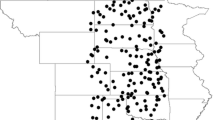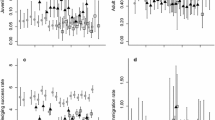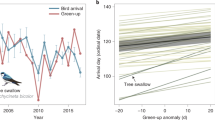Abstract
Migratory animals pose unique challenges for conservation biologists, and we have much to learn about how migratory species respond to drivers of global change. Research has cast doubt on the stability of the eastern monarch butterfly (Danaus plexippus) population in North America, but the western monarchs have not been as intensively examined. Using a Bayesian hierarchical model, sightings of western monarchs over approximately 40 years were investigated using summer flight records from ten sites along an elevational transect in Northern California. Multiple weather variables were examined, including local and regional temperature and precipitation. Population trends from the ten focal sites and a subset of western overwintering sites were compared to summer and overwintering data from the eastern migration. Records showed western overwintering grounds and western breeding grounds had negative trends over time, with declines concentrated early in the breeding season, which were potentially more severe than in the eastern population. Temporal variation in the western monarch also appears to be largely independent of (uncorrelated with) the dynamics in the east. For our focal sites, warmer temperatures had positive effects during winter and spring, and precipitation had a positive effect during spring. These climatic associations add to our understanding of biotic-abiotic interactions in a migratory butterfly, but shifting climatic conditions do not explain the overall, long-term, negative population trajectory observed in our data.





Similar content being viewed by others
References
Batalden RV, Oberhauser K, Peterson AT (2007) Ecological niches in sequential generations of eastern North American monarch butterflies (Lepidoptera: Danaidae): the ecology of migration and likely climate change implications. Environ Entomol 36:1365–1373
Brindza LJ, Brower LP, Davis AK, Van Hook T (2008) Comparative success of monarch butterfly migration to overwintering sites in Mexico from inland and coastal sites in Virginia. J Lepid Soc 62:189–200
Brower LP (1995) Understanding and misunderstanding the migration of the monarch butterfly (Nymphalidae) in North America: 1857–1995. J Lepid Soc 49:304–385
Brower AVZ, Boyce TM (1991) Mitochondrial-DNA variation in monarch butterflies. Evolution 45:1281–1286
Brower LP, Malcolm SB (1991) Animal migrations—endangered phenomena. Am Zool 31:265–276
Brower LP, Castilleja G, Peralta A, Lopez-Garcia J, Bojorquez-Tapia L, Diaz S, Melgarejo D, Missrie M (2002) Quantitative changes in forest quality in a principal overwintering area of the monarch butterfly in Mexico, 1971–1999. Conserv Biol 16:346–359
Brower LP, Fink LS, Walford P (2006) Fueling the fall migration of the monarch butterfly. Integr Comp Biol 46:1123–1142
Brower LP, Taylor OR, Williams EH, Slayback DA, Zubieta RR, Ramirez MI (2012) Decline of monarch butterflies overwintering in Mexico: is the migratory phenomenon at risk? Insect Conserv Diversity 5:95–100
Casner KL, Forister ML, O’Brien JM, Thorne J, Waetjen D, Shapiro AM (2014) Contribution of urban expansion and a changing climate to decline of a butterfly fauna. Conserv Biol 28:773–782
Chave J (2013) The problem of pattern and scale in ecology: what have we learned in 20 years? Ecol Lett 16:4–16
Congdon P (2014) Applied Bayesian modeling, vol. 595. Wiley
Daly C, Halbleib M, Smith JI, Gibson WP, Doggett MK, Taylor GH, Curtis J, Pasteris PP (2008) Physiographically sensitive mapping of climatological temperature and precipitation across the conterminous United States. Int J Climatol 28:2031–2064
Davis AK (2012) Are migratory monarchs really declining in eastern North America? Examining evidence from two fall census programs. Insect Conserv Divers 5:101–105
Davis, AK, Dyer LA (2015) Long-term trends in eastern North American monarch butterflies: a collection of studies focusing on spring, summer, and fall dynamics. Ann Entomol Soc Am 1–3
Dingle H, Zalucki MP, Rochester WA, Armijo-Prewitt T (2005) Distribution of the monarch butterfly, Danaus plexippus (L.) (Lepidoptera: Nymphalidae), in western North America. Biol J Linn Soc Lond 85:491–500
Flockhart DTT, Pichancourt J-B, Norris DR, Martin TG (2015) Unravelling the annual cycle in a migratory animal: breeding-season habitat loss drives population declines of monarch butterflies. J Anim Ecol 84:155–165
Forister ML, McCall AC, Sanders NJ, Fordyce JA, Thorne JH, O’Brien J, Waetjen DP, Shapiro AM (2010) Compounded effects of climate change and habitat alteration shift patterns of butterfly diversity. Proc Natl Acad Sci USA 107:2088–2092
Forister ML, Jahner JP, Casner KL, Wilson JS, Shapiro AM (2011) The race is not to the swift: long-term data reveal pervasive declines in California’s low-elevation butterfly fauna. Ecology 92:2222–2235
Frey DF, Schaffer A (2004) Spatial and temporal patterns of monarch overwintering abundance in Western North America. Monarch butterfly biology and conservation. Cornell University Press, Ithaca, NY, pp 167–176
Harrison JG, Shapiro AM, Espeset AE, Nice CC, Jahner JP, Forister ML (2015) Species with more volatile population dynamics are differentially impacted by weather. Biol Lett 11:5
Hartzler RG (2010) Reduction in common milkweed (Asclepias syriaca) occurrence in Iowa cropland from 1999 to 2009. Crop Prot 29:1542–1544
Jepsen S, Black SH (2015) Understanding and conserving the Western North American monarch population. In: Oberhauser KR, Altizer NS (eds) Monarchs in a changing world. Biology and conservation of an iconic butterfly, chapter 11. Cornell University Press, Ithaca
Koenig WD (2006) Spatial synchrony of monarch butterflies. Am Midl Nat 155:39–49
Krischik V, Rogers M, Gupta G, Varshney A (2015) Soil-applied imidacloprid translocates to ornamental flowers and reduces survival of adult Coleomegilla maculata, Harmonia axyridis, and Hippodamia convergens lady beetles, and larval Danaus plexippus and Vanessa cardui butterflies. PLoS One 10:22
Lyons JI, Pierce AA, Barribeau SM, Sternberg ED, Mongue AJ, de Roode JC (2012) Lack of genetic differentiation between monarch butterflies with divergent migration destinations. Mol Ecol 21:3433–3444
Mantyka-Pringle CS, Martin TG, Rhodes JR (2012) Interactions between climate and habitat loss effects on biodiversity: a systematic review and meta-analysis. Global Change Biol 18:1239–1252
McGill BJ (2010) Matters of scale. Science 328:575–576
Monarch Net (2015) Monarch abundance data. http://monarchnet.uga.edu/
Morisette JT, Richardson AD, Knapp AK, Fisher JI, Graham EA, Abatzoglou J, Wilson BE, Breshears DD, Henebry GM, Hanes JM, Liang L (2008) Tracking the rhythm of the seasons in the face of global change: phenological research in the 21st century. Front Ecol Environ 7:253–260
Morris GM, Kline C, Morris SM (2015) Status of Danaus plexippus population in Arizona. J Lepid Soc 69:91–107
Nice CC, Forister ML, Gompert Z, Fordyce JA, Shapiro AM (2014) A hierarchical perspective on the diversity of butterfly. Species’ responses to weather in the Sierra Nevada Mountains. Ecology 95:2155–2168
North American Butterfly Association (NABA) (2015) NABA butterfly counts from 1990 to 2009
Oberhauser K, Peterson AT (2003) Modeling current and future potential wintering distributions of eastern North American monarch butterflies. Proc Natl Acad Sci USA 100:14063–14068
Oberhauser KS, Nail KR, Altizer SM (2015) Monarchs in a changing world: biology and conservation of an iconic butterfly. Comstock, Ithaca
Parmesan C (2006) Ecological and evolutionary responses to recent climate change. Annu Rev Ecol Evol Syst 37:637–669
Pecenka JR, Lundgren JG (2015) Non-target effects of clothianidin on monarch butterflies. Nat Sci 102:19
Pleasants JM, Oberhauser KS (2012) Milkweed loss in agricultural fields because of herbicide use: effect on the monarch butterfly population. Insect Conserv Divers 6:135–144
Plummer M (2013) JAGS: a program for analysis of Bayesian graphical models using Gibbs sampling. Version 3:4
Plummer M (2015) Package rjags. Version 3-15
Pollard E (1977) Method for assessing changes in abundance of butterflies. Biol Conserv 12:115–134
Ponciano JM, Taper ML, Dennis B, Lele SR (2009) Hierarchical models in ecology: confidence intervals, hypothesis testing, and model selection using data cloning. Ecology 90:356–362
PRISM Climate Group (2015) Weather data. Oregon State University. http://prism.oregonstate.edu/
Ries L, Taron DJ, Rendón-Salinas E (2015) The disconnect between summer and winter monarch trends for the Eastern migratory population: possible links to differing drivers. Ann Entomol Soc Am 1–9
Royle JA, Dorazio RM (2008) Hierarchical modeling and inference in ecology: the analysis of data from populations, metapopulations and communities. Academic Press, Boston
R Core Team (2014) R: a language and environment for statistical computing. Version 3.1.2. R Foundation for Statistical computing, Vienna
Saenz-Romero C, Rehfeldt GE, Duval P, Lindig-Cisneros RA (2012) Abies religiosa habitat prediction in climatic change scenarios and implications for monarch butterfly conservation in Mexico. For Ecol Manage 275:98–106
Schonher T, Nicholson SE (1989) The relationship between California rainfall and ENSO events. J Clim 2:1258–1269
Shapiro AM (2014) Species presence by site. Art Shapiro’s butterfly site. http://butterfly.ucdavis.edu/
Stevens SR, Frey DF (2010) Host plant pattern and variation in climate predict the location of natal grounds for migratory monarch butterflies in western North America. J Insect Conserv 14:731–744
The Xerces Society (2015)Western Monarch Thanksgiving Count from 1997 to 2014. http://www.xerces.org/wp-content/uploads/2011/04/WMTC-Data-1997-2014.pdf
Tylianakis JM, Didham RK, Bascompte J, Wardle DA (2008) Global change and species interactions in terrestrial ecosystems. Ecol Lett 11:1351–1363
Urquhart FA, Urquhart NR (1977) Overwintering areas and migratory routes of monarch butterfly (Danaus plexippus, Lepidoptera Danaidae) in North America, with special reference to western population. Can Entomol 109:1583–1589
Vidal O, Rendon-Salinas E (2014) Dynamics and trends of overwintering colonies of the monarch butterfly in Mexico. Biol Conserv 180:165–175
Weiss SB, Rich PM, Murphy DD, Calvert WH, Ehrlich PR (1991) Forest canopy structure at overwintering monarch butterfly sites: measurements with hemispherical photography. Conserv Biol 5:165–175
Wolter K, Timlin MS (1993) Monitoring ENSO in COADS with a seasonally adjusted principal component index. Proceedings of the 17th Climate Diagnostic,Norman, OK. pp 52–57
Wu Z, Dijkstra P, Koch GW, Penuelas J, Hungate BA (2011) Responses of terrestrial ecosystems to temperature and precipitation change: a meta-analysis of experimental manipulation. Global Change Biol 17:927–942
Zalucki MP, Lammers JH (2010) Dispersal and egg shortfall in monarch butterflies: what happens when the matrix is cleaned up? Ecol Entomol 35:84–91
Zalucki MP, Brower LP, Malcolm SB, Slager BH (2015) Estimating the climate signal in monarch population decline. In: Oberhauser KR, Altizer NS (eds)Monarchs in a changing world. Biology and conservation of an iconic butterfly, chapter 11. Cornell University Press, Ithaca
Zhan S, Zhang W, Niitepold K, Hsu J, Haeger JF, Zalucki MP, Altizer S, de Roode JC, Reppert SM, Kronforst MR (2014) The genetics of monarch butterfly migration and warning colouration. Nature 514:317–321
Zipkin EF, Ries L, Reeves R, Regetz J, Oberhauser KS (2012) Tracking climate impacts on the migratory monarch butterfly. Global Change Biol 18:3039–3049
Acknowledgments
We thank the citizen science participants of the Western Monarch Thanksgiving Count and the Fourth of July Butterfly Counts, as well as two anonymous reviewers of an early draft. Much appreciation goes to the Xerces Society and the North American Butterfly Association, respectively associated with the aforementioned counts, for making the data publicly available and providing them online through Monarch Net. This research was supported in part by the Trevor James McMinn professorship to M. L. F. and by the National Science Foundation (DEB-1050726, and DEB-1145609).
Author contribution statement
A. E. E. and M. L. F. conceived the idea. A. M. S. collected the data. C. C. N., A. E. E., J. G. H., M. L. F., and J. A. F. developed the statistical models; J. H. T. and D. P. W. managed and archived the data; A. E. E., J. G. H., and M. L. F. wrote the manuscript, while A. M. S., C. C. N., J. H. T., D. P. W., and J. A. F. reviewed the manuscript before submission.
Author information
Authors and Affiliations
Corresponding author
Ethics declarations
Conflict of interest
The authors declare that they have no conflict of interest.
Additional information
Communicated by Klaus Fischer.
Electronic supplementary material
Below is the link to the electronic supplementary material.
Rights and permissions
About this article
Cite this article
Espeset, A.E., Harrison, J.G., Shapiro, A.M. et al. Understanding a migratory species in a changing world: climatic effects and demographic declines in the western monarch revealed by four decades of intensive monitoring. Oecologia 181, 819–830 (2016). https://doi.org/10.1007/s00442-016-3600-y
Received:
Accepted:
Published:
Issue Date:
DOI: https://doi.org/10.1007/s00442-016-3600-y




